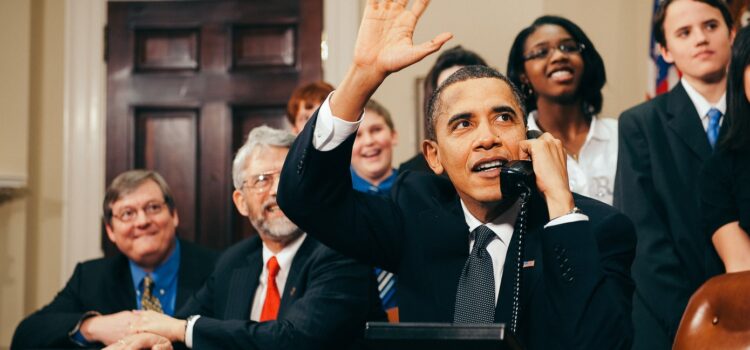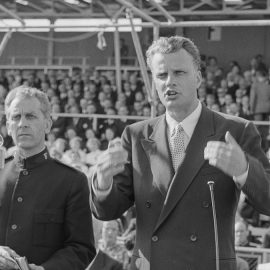

This article is an excerpt from the Shortform book guide to "A Promised Land" by Barack Obama. Shortform has the world's best summaries and analyses of books you should be reading.
Like this article? Sign up for a free trial here .
Who were the cabinet members during the first Obama Administration? Why did he choose them?
Obama’s cabinet members were chosen carefully by Obama and his staff. Amongst others, Obama had to select a chief of staff, secretary of the treasury, and secretary of state.
Read more about the Obama cabinet members and how they chose him.
Obama Cabinet Members: Administration Takes Shape
In November and December 2008, Barack Obama—now President-elect Obama—was preparing to assume the most powerful office in the world. Beyond the obvious gravity of the responsibilities he was set to assume, Barack and his family saw their daily lives changing before their eyes, their privacy and normalcy melting away, never to return again.
Michelle and the girls now had to get used to living under the shadow of the Secret Service and adhering to the myriad security protocols necessary for protecting the nation’s first Black First Family. Barack saw—with some amusement, but also disquiet—how he now entered and left buildings through deserted service entrances and side doors, accompanied by a phalanx of Secret Service agents. Even in the midst of bustling cities like Chicago and Washington, D.C., the security procedures left him living in a virtual ghost town wherever he went.
But there was little time to focus on this. He now had the monumental task before him of forming a government during the nation’s worst economic crisis since the Great Depression.
Staffing Up and the Realities of Governing
Obama first needed to assemble his core White House team. Although the vast majority of the rank-and-file employees across the various executive and independent agencies were career civil servants and thus, would not have to be replaced by a new administration, there were still thousands of political appointments that would need to be filled during the transition.
As Obama began to fill out his core team, he (and many of his more progressive supporters) had to learn a tough lesson: Governing was different from campaigning. In order to make change, he would need to work with people who knew how to work the system in Washington—and that meant relying on Washington pros and insiders. Most of the team he assembled consisted of former Clinton administration officials. In general, they were center-left policy wonks, who tended to be older than Obama and have more market-friendly views than some of the liberal activists who’d flocked to the Obama campaign.
Obama needed to start at the top, finding a White House Chief of Staff who could coordinate the day-to-day activities of the Office of the President, build alliances across the executive branch and Congress to implement the president’s agenda, and generally serve as the chief executive’s eyes and ears in Washington. Although not a constitutional role, the White House Chief of Staff had unrivaled access to the president and was generally considered to be one of the most powerful jobs in the country—if not the world.
Rahm Emanuel: Chief of Staff
One of the important Obama cabinet members was the chief of staff. For his first chief of staff, Obama selected Rahm Emanuel. Emanuel was a veteran of the Clinton White House, a former member of Congress, and a former investment banker.
His mix of political experience, relationships on Capitol Hill, background in the world of finance, and personal relationship with Obama (the two men knew each other from the Chicago political scene) made him an attractive choice for Obama.
Emanuel was known as a take-no-prisoners political brawler with a brash style and a famously expletive-laden speaking style. Obama knew that his chief of staff would be a fearless public advocate for his agenda, but still independent-minded enough to give him the necessary tough advice that others might be afraid to give a president.
Still, the choice of Emanuel wasn’t uniformly popular among Obama’s backers. Some, especially on the left flank of the Democratic Party, disliked his background with the famously centrist Clintons—especially coming after the tough 2008 primary fight.
They saw Emanuel as an unprincipled Clinton-style centrist, someone who would always try to position Obama away from left-wing policy positions and tack toward the political center—regardless of the policy merits of such an approach.
Obama understood this criticism. He recognized that Emanuel could sometimes be more concerned with earning something he could label as a political “win” rather than the actual substance of that “win.” Nevertheless, he respected his chief of staff’s political instincts and knowledge of how Washington worked.
Timothy Geithner: Secretary of the Treasury
With Rahm Emanuel in place as chief of staff, Obama next pivoted to building his core economic team. Given the unfolding economic crisis, these were the most important and most closely watched of his early staffing choices.
Obama selected Timothy Geithner, an experienced Washington insider, to serve as Secretary of the Treasury. Geithener had been closely involved in monetary policymaking as head of the Federal Reserve Bank of New York, after having served in a senior role at the Treasury Department during the Clinton administration.
Despite his relative youth at age 47, Geithner was widely regarded as smart, experienced, pragmatic, and solution-oriented. However, he came in for the same line of criticism as Rahm Emanuel. As a key central banker, he’d been in a position of responsibility during the inflation of the housing bubble and resulting crash. During the Clinton years, he’d been part of a Treasury department that had started the wave of financial deregulation (continued eagerly under Bush) that had contributed to the financial crisis.
But Obama was a pragmatist. He believed that it was essential to tap people who had the right mix of relevant experience and ideology, even if they may have been “tainted” by involvement with bad policies in the past. Although he had campaigned as a fresh-faced outsider and genuinely believed that there were serious problems with America’s governing class in both major parties, he was not a revolutionary. Obama wanted the best, most competent people in place.
While someone not in a position of responsibility might have the luxury of imagining a fundamental reworking of the economic order, Obama was not in such a position. He was in charge during a crisis that threatened the livelihoods of millions of American families. His job was to stave off an economic disaster, not impose upon the nation a left-wing economic revolution. He was one of the important cabinet members who helped balance the group.
Hillary Clinton: Secretary of State
One of the more famous Obama cabinet members was Hilary Clinton. For Secretary of State, the nation’s top diplomat, Obama selected his chief rival from the primaries, Hillary Clinton.
Since defeating Clinton in the primary, Obama knew that he would need to tap her skills and experience. Although he and his team quickly decided that having Hillary serve as vice president would be too awkward a pairing (and potentially give former President Bill Clinton too large a role in the Obama White House), Obama never considered shutting her out of the administration—especially since she’d selflessly put aside the divisions of the primary and been a loyal and dedicated campaigner for him during the general election.
Her selection as Secretary of State was not, however, made for political considerations or out of a desire to unify the Democratic Party. Obama selected Clinton because he believed she was the most qualified candidate for the job.
America had suffered deep damage to its international reputation during the Bush years due to the failures in Iraq and Afghanistan and its clear scorn for international opinion as it waged the so-called War on Terror.
Obama believed that Hillary Clinton’s sterling reputation as a policy expert, her famed work ethic, and her international star power would make her an effective representative for the U.S. on the world stage as she worked to rebuild America’s frayed network of alliances.
Robert Gates: Secretary of Defense
Perhaps the most interesting cabinet decision Obama made in his first term was to retain the Republican Robert Gates as Secretary of Defense. Gates had been installed by the Bush administration after the failures of Donald Rumsfeld’s tenure at Defense.
Gates certainly cut a contrasting figure from Obama: He was a Republican, former Cold War hawk, and a supporter of the invasion of Iraq that Obama had so fiercely opposed. But, like Obama’s cabinet selections at other departments, Gates also had the relevant experience—in his case, managing the vast and powerful bureaucracy of the Pentagon. Moreover, Gates was not some wild-eyed neoconservative ideologue in the mold of Dick Cheney or Donald Rumsfeld. Rather, he was a realist and a pragmatist, with a keen understanding of the limitations of American military power.
Indeed, he’d delivered real success in Iraq, significantly improving the situation from the chaotic mess he’d inherited—giving the nascent Iraqi government some space to operate. Perhaps most promising for Obama, Gates agreed with him on the need for a timetable for the withdrawal of U.S. troops from Iraq, which the outgoing Bush administration had long rejected.
Obama hoped that keeping Gates on at Defense would show Republicans that he was serious about his commitment to bipartisanship. He also hoped that having an experienced and trusted hand like Gates on board would help both the military and the civilian bureaucracy at the Pentagon (both of which Obama assumed would be generally distrustful of a liberal president who’d never served in the armed forces) acclimate themselves to the new administration.
Choosing Gates was a demonstration of Obama’s innate pragmatism. Despite his opposition to the War in Iraq, Obama was not a pacifist opposed to war in all cases. As awful as it was, Obama recognized that war was sometimes necessary for national security, human rights or the nation’s strategic interests. He wanted policies and personnel that would be effective more than he wanted to tick boxes on the left-wing agenda.

———End of Preview———
Like what you just read? Read the rest of the world's best book summary and analysis of Barack Obama's "A Promised Land" at Shortform .
Here's what you'll find in our full A Promised Land summary :
- How Barack Obama went from relative obscurity to the first Black president
- What principles guided his political leadership style
- Why Obama retained an unshakable faith in the potential and promise of America






